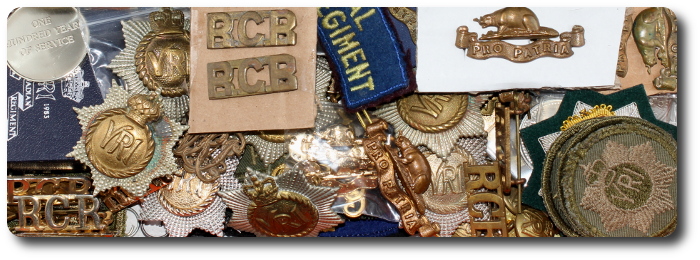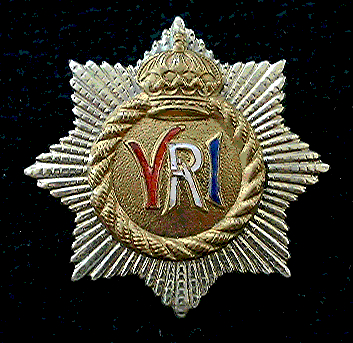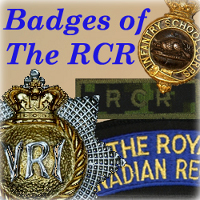
An Uncommon Cap Badge of The Royal Canadian Regiment
Help me identify the origins of this unique badge. - Read Received comments below. - View other badges of The RCR.
In my collection of cap badges for The RCR, ranging from 1883 to the present, the ones that I have are all represented (exactly or closely) in the Regimental Museum, with one notable exception. The photo below illustrates this unique variation:

Notable aspects of this 1894-1902 style cap badge include:
- The back plate has very well-defined radial striations while the concentric striations are very faint by comparison. (The radial and concentric striations are normally almost equal in depth.)
- The back plate has two perforations just inside the back studs, originally designed to take tabs on the back of the frontispiece, but it has not been assembled by that method. (I also have a 1950s badge with similar mounting holes, but it is certainly not the same backpiece.)
- The "V," "R," and "I" have been coloured red, white and blue, respectively. the colour appears to be a baked enamel finish and not paint.
I would appreciate any observations or comments to help me determine the origin of this particular badge.
Thank you.
The Regimental Rogue - e-mail
Comments received regarding this badge:
From John R. Grodzinski:-- "Very interesting. I've never seen one like this, but it is very, very interesting. The fact that it was enameled as opposed to painted means that some money was spent on it. The colours of course, are those of the Empire (the British that is, not the American). Given the timeframe of the badge, it may have been prepared for the Jubilee in 1897 or perhaps the Coronation in 1902. Either way, it was some celebratory variation.
From Mr Grimshaw, a collector contacted by the RCR Regimental Museum:-- "First, the RCR badge. It is not unique; I have one almost identical and I think I recall that Tony Reintjes of London has one as well. Mr. O'Leary did not mention attachments on the back; mine has the usual loops or "lugs" for a cotter pin which indicate use as a cap badge. If a brooch pin were present, it might indicate use as a sweetheart pin. My badge has the distinctive "hob-nail" white metal star rather than the "rayed" star as illustrated. However, the gilding metal overlay with enameled VRI is identical as is the method of construction. Given the latter, I conclude that the overlay was removed for enamelling, probably fired in a kiln, and the tabs were removed so it would lie flat during that process, after which the overlay was re-attached probably by soldering. That would indicate work by a manufacturing jeweler. That in turn, means that someone had these badges modified for a purpose. However, none of the reference books mentions this variety. If there is any "lore" about this, it would likely be in the RCR archives. Given the red, white and blue enameling, that is not the regimental colours, I suspect some patriotic purpose such as for regimental contingents to Queen Victoria's Jubilees, escorts for a Royal Visit, possibly the Coronation 1902, or even Queen Victoria's funeral. I would start looking for some kind of explanation in regimental accounts of participation in those kinds of events of the period. That is my best guess. One thing is now quite certain, that the badge in question is NOT a "one-off" made-up by some enterprising or bored soldier for his own use, but is one of a number of badges that were re-manufactured for a specific purpose."
(Note that the mounting on my copy of this badge has the standard lugs for cotter pit attachment. - MMO)
- The O'Leary Collection; Medals of The Royal Canadian Regiment.
- Researching Canadian Soldiers of the First World War
- Researching The Royal Canadian Regiment
- The RCR in the First World War
- Badges of The RCR
- The Senior Subaltern
- The Minute Book (blog)
- Rogue Papers
- Tactical Primers
- The Regimental Library
- Battle Honours
- Perpetuation of the CEF
- A Miscellany
- Quotes
- The Frontenac Times
- Site Map
QUICK LINKS

1. Introduction
2. Crowns, Cyphers and Controversy
3. Rare and Unusual Regimental Badges
4. Shoulder Flashes and Titles
1883
1894-1902, 1919-27
South African War
EviiR Badges (1902-11)
GvR Badges (1911-19)
St Edward's Crowns (1927-70s)
Maj Cock, M.C., Collection (1933)
Imperial Crowns (1926-50s)
Imperial Crowns (1960s-80s)
Dress Regs - 1960
Dress Regs - 1967
1980s
1990s
2000+
Woven Badges
Blazer Badges
Pipers' Badges
Belt Buckles
Miscellaneous
Crowns, Cyphers and Stars
RCR Headdress
Badged Brodies
Badge References